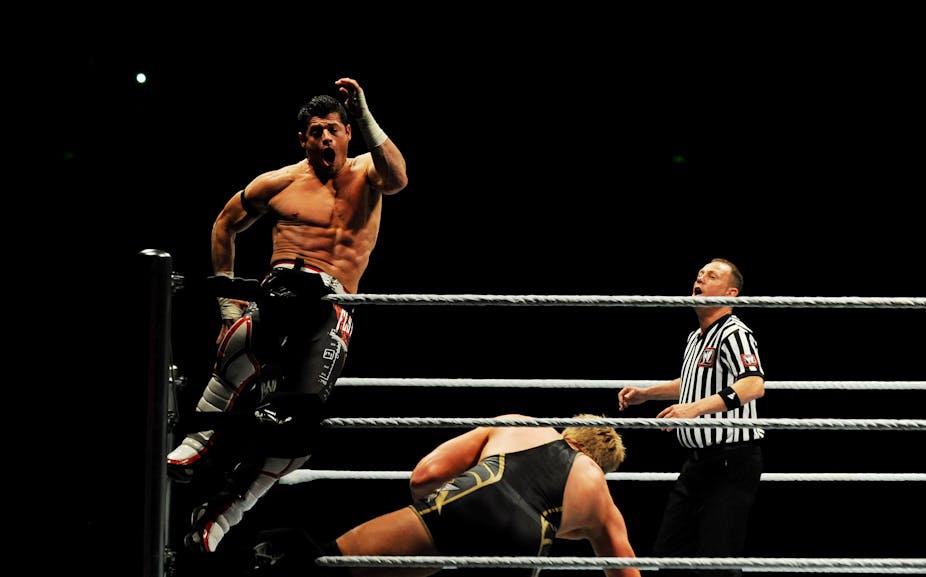In August, one of the world’s largest and most successful live theatre companies will travel to Australia for a series of shows that will most likely play to packed audiences. But it’s likely you won’t read about them in the local arts pages or theatre guides. And most well known theatre critics will likely ignore them.
That’s partly because this particular theatre company’s productions tend more to the melodramatic than to high art, and are targeted at working-class men. I’m speaking, of course, of WWE — World Wrestling Entertainment — which will tour Brisbane, Sydney and Melbourne in August.
Critics will no doubt scoff at the comparison of pro-wrestling to theatre, seeing it as nothing more than a bawdy, sexist, overblown spectacle that celebrates a particularly regressive form of masculinity.
All of which is true enough. But then again, the same might be said of a good deal of theatre – not to mention culture generally.
Perhaps the easiest way to view pro-wrestling is that it’s soap opera for men. That might sound far-fetched to the casual observer whose idea of soaps is Home and Away or The Bold and the Beautiful. Say what you want about soaps, but at least there’s the hint of a story there.

But as any wrestling fan will attest, the match is only one component of a much longer storyline of grudges, betrayal, backstabbing, threats, and innuendo. The form and structure of pro-wrestling is pretty much the same as soap operas: circular storytelling, use of melodrama, morality tales centred around family and the personal honour and pride.
The eventual match is only one component. Often what’s more important are the pre- and post-match interviews, and the preceding actions are more interesting (and fun) than the match itself.
If you doubt that wrestling is soap opera, then just see how many weddings have been held in the ring over the years. And as in any self-respecting soap, the weddings are usually interrupted by some jilted suitor/ husband/ wife intent on revenge.
This makes the oft-heard complaint about pro-wrestling by critics that “it’s not real” bizarre. The equivalent would be walking out of a Bell Shakespeare performance and complaining that the actors were all putting it on.
As the French theorist Roland Barthes noted in a 1957 essay:
There is no more a problem of truth in wrestling than in the theatre. In both, what is expected is the intelligible representation of moral situations which are usually private.
Barthes continued:
What is thus displayed for the public is the great spectacle of Suffering, Defeat, and Justice. Wrestling presents man’s suffering with all the amplification of tragic masks.
As the audience for pro-wrestling has aged and grown, the stories have become more complex, with reality increasingly blurring with the fantasy world in the ring.

For those of us who grew up in the 1980s watching the World Wrestling Federation, as the WWE was then known, the storylines were often simple fables of good versus evil in which good eventually triumphed. Occasionally a good guy turned “heel” - as bad guys are known in wrestling parlance - and vice versa, but the results were usually predictable.
By the late 1980s and early 1990s, the formula was becoming stale. Its core audience was no longer satisfied with simple good-versus-bad morality tales.
Around the same time, the organisation was hit by a series of scandals, including allegations of sexual harassment and investigations for steroid use among wrestlers. The idea that wrestling was family-friendly entertainment was getting harder to sell. The biggest morality tale wasn’t in the ring, but the real-life doings of the company.
In a postmodern twist, the WWE reinvented itself in the mid- to late-1990s, incorporating the sleaze into the script with more irreverent, bawdy storylines. The real life soap opera that had enveloped the WWE, and threatened to destroy the company, provided a ready supply of material for new storylines. Increasingly, the behind-the-scenes feuds and personal rivalries became the inspiration for the matches.
Meanwhile, Vince McMahon Jnr, the owner of WWE — who up to that point had played the straight-faced commentator who cheered the good wrestlers and booed the bad — was written into the storylines as the meddling, nepotistic owner, playing his favourites and family members against one another. Some characters were out for themselves, or else minions of the company. Wrestling once again seemed edgy and grabbed back its adult audience.

The strategy worked for a time, but as wrestling has become more popular and attracted family audiences, the storylines have once again become more restrained. It’s a strategy that’s working, as the WWE extends beyond wrestling shows to video streaming businesses and feature films.
Is pro-wrestling up there with Shakespeare? No, clearly it’s not. Is it politically incorrect, irreverent and silly? Absolutely. But there’s also more to it than muscle-bound men pretending to hit each other.
WWE tours Australia in August. Details here.

